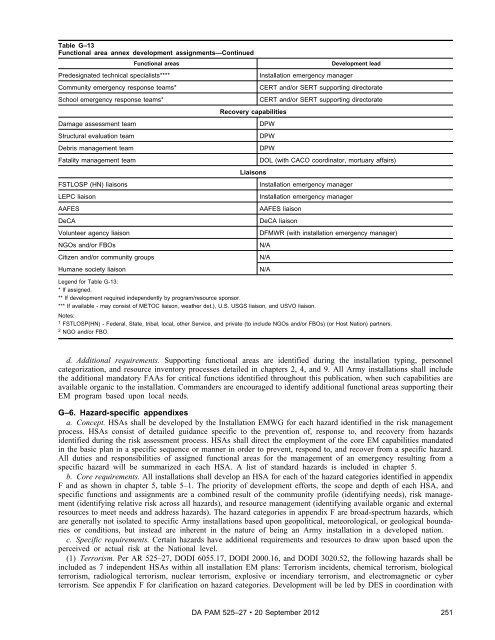Army Emergency Management Program - Federation of American ...
Army Emergency Management Program - Federation of American ...
Army Emergency Management Program - Federation of American ...
Create successful ePaper yourself
Turn your PDF publications into a flip-book with our unique Google optimized e-Paper software.
Table G–13<br />
Functional area annex development assignments—Continued<br />
Functional areas Development lead<br />
Predesignated technical specialists**** Installation emergency manager<br />
Community emergency response teams* CERT and/or SERT supporting directorate<br />
School emergency response teams* CERT and/or SERT supporting directorate<br />
Recovery capabilities<br />
Damage assessment team DPW<br />
Structural evaluation team DPW<br />
Debris management team DPW<br />
Fatality management team DOL (with CACO coordinator, mortuary affairs)<br />
Liaisons<br />
FSTLOSP (HN) liaisons Installation emergency manager<br />
LEPC liaison Installation emergency manager<br />
AAFES AAFES liaison<br />
DeCA DeCA liaison<br />
Volunteer agency liaison DFMWR (with installation emergency manager)<br />
NGOs and/or FBOs N/A<br />
Citizen and/or community groups N/A<br />
Humane society liaison N/A<br />
Legend for Table G-13:<br />
* If assigned.<br />
** If development required independently by program/resource sponsor.<br />
*** If available - may consist <strong>of</strong> METOC liaison, weather det.), U.S. USGS liaison, and USVO liaison.<br />
Notes:<br />
1 FSTLOSP(HN) - Federal, State, tribal, local, other Service, and private (to include NGOs and/or FBOs) (or Host Nation) partners.<br />
2 NGO and/or FBO.<br />
d. Additional requirements. Supporting functional areas are identified during the installation typing, personnel<br />
categorization, and resource inventory processes detailed in chapters 2, 4, and 9. All <strong>Army</strong> installations shall include<br />
the additional mandatory FAAs for critical functions identified throughout this publication, when such capabilities are<br />
available organic to the installation. Commanders are encouraged to identify additional functional areas supporting their<br />
EM program based upon local needs.<br />
G–6. Hazard-specific appendixes<br />
a. Concept. HSAs shall be developed by the Installation EMWG for each hazard identified in the risk management<br />
process. HSAs consist <strong>of</strong> detailed guidance specific to the prevention <strong>of</strong>, response to, and recovery from hazards<br />
identified during the risk assessment process. HSAs shall direct the employment <strong>of</strong> the core EM capabilities mandated<br />
in the basic plan in a specific sequence or manner in order to prevent, respond to, and recover from a specific hazard.<br />
All duties and responsibilities <strong>of</strong> assigned functional areas for the management <strong>of</strong> an emergency resulting from a<br />
specific hazard will be summarized in each HSA. A list <strong>of</strong> standard hazards is included in chapter 5.<br />
b. Core requirements. All installations shall develop an HSA for each <strong>of</strong> the hazard categories identified in appendix<br />
F and as shown in chapter 5, table 5–1. The priority <strong>of</strong> development efforts, the scope and depth <strong>of</strong> each HSA, and<br />
specific functions and assignments are a combined result <strong>of</strong> the community pr<strong>of</strong>ile (identifying needs), risk management<br />
(identifying relative risk across all hazards), and resource management (identifying available organic and external<br />
resources to meet needs and address hazards). The hazard categories in appendix F are broad-spectrum hazards, which<br />
are generally not isolated to specific <strong>Army</strong> installations based upon geopolitical, meteorological, or geological boundaries<br />
or conditions, but instead are inherent in the nature <strong>of</strong> being an <strong>Army</strong> installation in a developed nation.<br />
c. Specific requirements. Certain hazards have additional requirements and resources to draw upon based upon the<br />
perceived or actual risk at the National level.<br />
(1) Terrorism. Per AR 525–27, DODI 6055.17, DODI 2000.16, and DODI 3020.52, the following hazards shall be<br />
included as 7 independent HSAs within all installation EM plans: Terrorism incidents, chemical terrorism, biological<br />
terrorism, radiological terrorism, nuclear terrorism, explosive or incendiary terrorism, and electromagnetic or cyber<br />
terrorism. See appendix F for clarification on hazard categories. Development will be led by DES in coordination with<br />
DA PAM 525–27 20 September 2012<br />
251
















